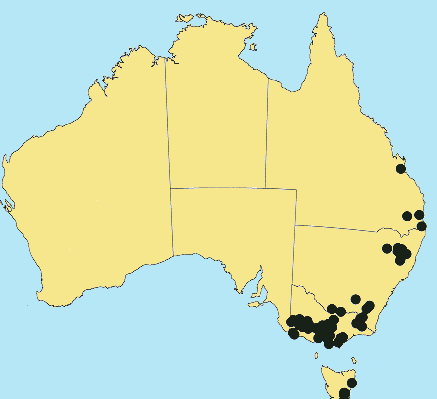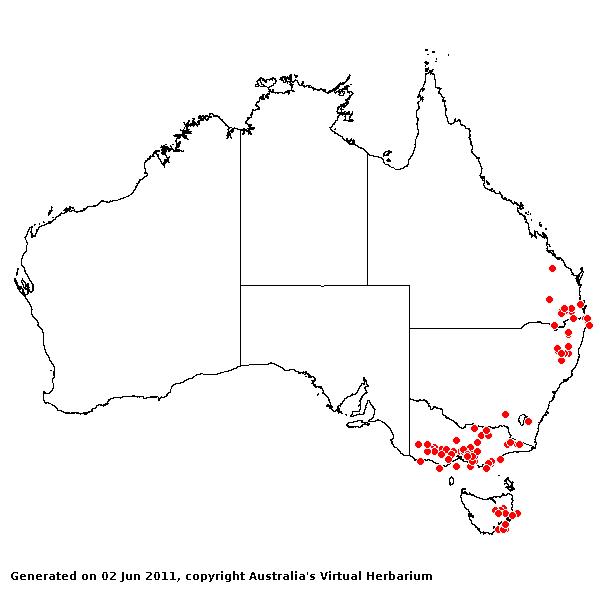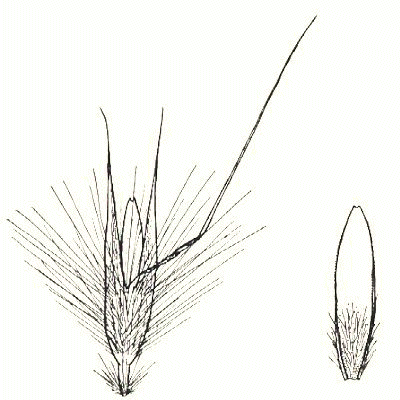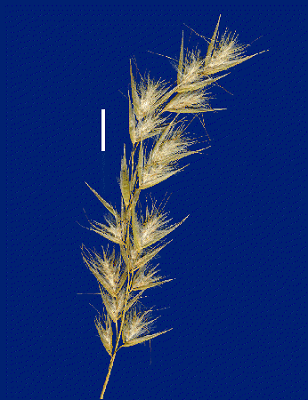Rytidosperma indutum (Vickery) Connor
& Edgar. New Zealand J. Bot. 17: 332 (1979).
Classification. (GPWG 2001) : Subfamily Danthonioideae. Tribe
Danthonieae.
Basionym and/or
Replacement Name: Danthonia
induta Vickery, Contr. New South Wales Natl. Herb. 1(5): 298 (1950).
Type of Basionym or
Protologue Information: HT: Ingram s.n., Dec 1938, Australia: New
South Wales: Armidale (NSW-1344; IT: K).
Recent synonyms:
Notodanthonia induta (Vickery) Veldkamp, Rytidosperma procerum
(Vickery) Connor & Edgar, Danthonia procera Vickery, Notodanthonia
procera (Vickery) Veldkamp, Austrodanthonia procera (Vickery)
S.W.L.Jacobs, Austrodanthonia induta (Vickery) H.P. Linder.
Key references
(books and floras): [2002] D.Sharp & B.K.Simon, AusGrass, Grasses of
Australia, [2006] J.Jessop, G.R.M.Dashorst, F.M.James, Grasses of South
Australia (292), [2008] S.W.L.Jacobs, R.D.B.Walley & D.J.B.Wheeler, Grasses
of New South Wales (144).
Illustrations:
[2006] J.Jessop, G.R.M.Dashorst, F.M.James, Grasses of South Australia (292,Ffig. 228), [2008] S.W.L.Jacobs,
R.D.B.Whalley & D.J.B.Wheeler, Grasses of New South Wales, 4th edn
(144and 146, as A. procera).
Derivation: L.
induo, clothe. Glumes and/or lemmas densely hairy.
Habit.
Perennial. Culms stature robust to moderate, 75–120 cm tall, 2.5–3.5 mm diam.,
4 -noded. Leaf-sheaths glabrous on surface. Ligule a fringe of hairs.
Leaf-blades flat or involute, 15–30 cm long, 1.5–4 mm wide. Leaf-blade surface
glabrous.
Inflorescence.
Inflorescence solid, a panicle. Panicle linear to elliptic, 9–18 cm long.
Spikelets.
Spikelets pedicelled. Fertile spikelets many flowered, with at least 2 fertile
florets (3), comprising 3 fertile floret(s), with diminished florets at the
apex, cuneate, laterally compressed, 14–18 mm long.
Glumes. Glumes
similar, thinner than fertile lemma. Lower glume lanceolate, membranous, much
thinner on margins, without keels, 5–7 -nerved. Upper glume lanceolate, 14–18
mm long, membranous, without keels, 5–7 -nerved.
Florets.
Fertile lemma 10–11 mm long, without keel, 9 -nerved. Lemma surface indumented.
Lemma apex lobed, awned, 3 -awned. Median (principal) awn from a sinus, 13–18
mm long overall, with a twisted column. Column 4–6 mm long. Lateral lemma awns
present. Lodicules present. Anthers 3.
Continental
Distribution: Australasia.
Australian Distribution:
South Australia, Queensland, New South Wales, Victoria, Tasmania.
South Australia:
Southern Lofty, South-eastern. Queensland: Darling Downs, Moreton. New
South Wales: Northern Tablelands, Central Tablelands. Victoria: East
Gippsland, Gippsland Highlands, Gippsland Plain, Grampians, Midlands, Otway
Plain, Otway Range, Riverina, Wannon. Tasmania: Midlands, East Coast.
Notes. This
appears to be a very distinctive species, allied to R. fulvum by the
long paleas, and relatively short setae, but distinct by the paleas almost as
long as the lemma lobes, by the glabrous appearance of the plants, and by the
size of the tussocks. It may also be confused with R. tenuius, which has
much shorter paleas.
Ranging
from southern Queensland to the South Australian border, altitude 40–1600 m, on
steep or rocky hillsides and roadverges, often in Eucalyptus woodland.
Flowers Nov. to April.
